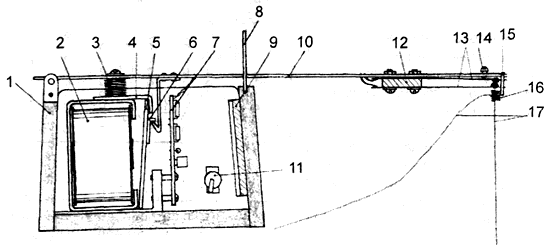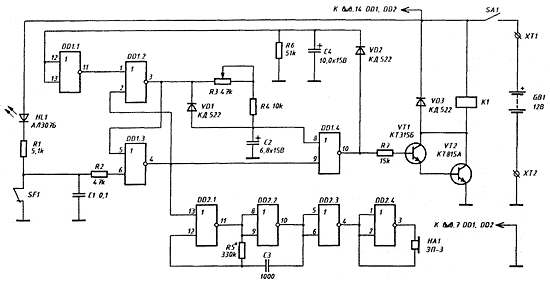
|
|
ENCYCLOPEDIA OF RADIO ELECTRONICS AND ELECTRICAL ENGINEERING Electronic-mechanical fishing rod
Encyclopedia of radio electronics and electrical engineering / Home, household, hobby Anglers know how important it is not to miss the moment of the beginning of the bite and to hook the fish in time. The proposed device is able to solve this problem independently. It produces automatic hooking of fish, which greatly increases the efficiency of fishing. The appearance of an electronic-mechanical fishing rod is shown in Fig.1. Here: 1 - housing from the RPU-2 alternating current relay, in which the electromagnet winding 2 is located, the board 7 with the electronic part of the fishing rod and the piezo emitter 9; 3 - undercutting spring; 4 - emphasis of the armature of the electromagnet 5; 6 - mechanical latch; 8- rocker motion limiter; 10 - rocker made of fiberglass 1,5 mm thick. 25 mm wide and 270 mm long; 11 - fishing rod power switch; 12 - insulating plate; 13 - electrical contact from the contact group of the RPU-2 relay, which serves as a bite sensor; 14- sensor sensitivity adjustment screw; 15 - emphasis of the contact pair; 16 - a spring soldered to the lower contact of the sensor in the figure, for attaching fishing line 17.
The electrical circuit of the fishing rod is shown in Fig.2. SF1 is a bite sensor. The presence of a contact in it is indicated by the HL1 indicator. Elements DD1.1 ... DD1.3 form a trigger; VD1, R3, R4, C2 - timing chain that determines the holding time of the armature by electromagnet K1; VD2, R6, C4 - a timing circuit that determines the transition time of the trigger to its original state after the bite stops and the electromagnet is released. On the elements DD2.1 ... DD2.4, a generator of sound vibrations is assembled; DD1.4, VT1, VT2 form an electromagnet control signal amplifier; SA1 - MTZ rod power switch, de-energizing the electronic part when changing the bait and bringing the mechanical part of the rod to its original position; GB1 is a 12 V nickel-cadmium battery with a capacity of 7 VA brand HV7-12.
The electronic fishing rod works as follows. In the initial position, the mechanical part of the rod is in the cocked state. In this case, the spring 3 is maximally compressed and the rocker is connected to the armature using a latch 6. The initial state of the electronic part of the fishing rod is as follows: capacitors C2, C4 are charged; at the output of ZIMS DD1.2 there is a low level, and at pin 4 - high. When a bite occurs, the contacts of the SF1 sensor open, and the trigger goes into the active state (at pin 4 of DD1.3 - low level). The DD1.4 microcircuit element opens the transistors VT1, VT2 and the electromagnet is activated, attracting the armature to itself. The connection of the rocker with the anchor is broken, the compressed spring is straightened and the fish is hooked. With the beginning of the transition of the trigger to the active state, the capacitor C2 begins to charge, and after a time of about 0,5 seconds, determined by the values of the elements R3, R4 and C2, a low-level signal appears at pin 10 DD1.4 and the electromagnet releases. The trigger will return to its original state only after a certain time (about 0,5 seconds) necessary to calm the sensor contacts when the armature returns to its initial position and is determined by the discharge time of the now charged capacitor C4 through the resistor R6. As long as the trigger is active, the audio frequency generator works and notifies the angler of the presence of a bite. The generator frequency is selected by changing the resistance of the resistor R5. All parts of the electronic-mechanical fishing rod, with the exception of the HL1 LED, the R3 resistor and the SA1 switch, are mounted on a 40x55 mm printed circuit board (Fig. 3).
The electromagnet coil is wound on the frame (until it is completely filled) from the RPU-2 relay winding and contains about 4000 turns of PEV-2 wire with a diameter of 0,25 mm. The current consumption of such a coil during cutting is about 100 mA. It should be noted that the total current consumed by the electric fishing rod in standby mode does not exceed 3 mA. The sensitivity of the bite sensor is adjusted using a screw and a locknut with an M2,5 thread by pressing one contact to the other. Spring 3 creates an initial force equal to 250 g during hooking. The course of the line is about 10 cm. This turned out to be sufficient for the author to catch bottom fish (roach, bream, perch) from a boat at a depth of 6 ... - 7 mm, hook - 0,12 mm. Author: A. Omelyanyuk, Brest, Radio amateur; Publication: radioradar.net
Machine for thinning flowers in gardens
02.05.2024 Advanced Infrared Microscope
02.05.2024 Air trap for insects
01.05.2024
▪ Interactive panel for classrooms with motion sensors ▪ Making diamonds out of peanut butter ▪ Nanosensor detects pesticides on fruits
▪ section of the site The most important scientific discoveries. Article selection ▪ article State and municipal management. Crib ▪ article Can you really hypnotize a snake? Detailed answer ▪ article Krushina brittle. Legends, cultivation, methods of application ▪ article Universal radio signaling. Encyclopedia of radio electronics and electrical engineering ▪ article Miracle album. Focus Secret
Home page | Library | Articles | Website map | Site Reviews www.diagram.com.ua |






 Arabic
Arabic Bengali
Bengali Chinese
Chinese English
English French
French German
German Hebrew
Hebrew Hindi
Hindi Italian
Italian Japanese
Japanese Korean
Korean Malay
Malay Polish
Polish Portuguese
Portuguese Spanish
Spanish Turkish
Turkish Ukrainian
Ukrainian Vietnamese
Vietnamese



 Leave your comment on this article:
Leave your comment on this article: